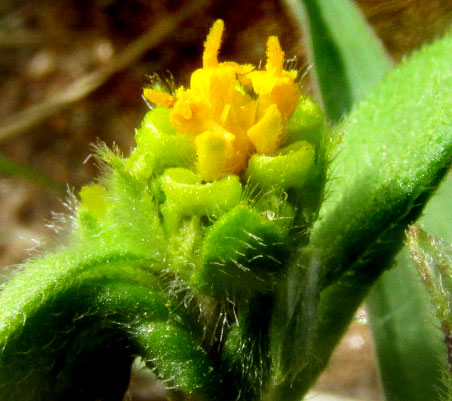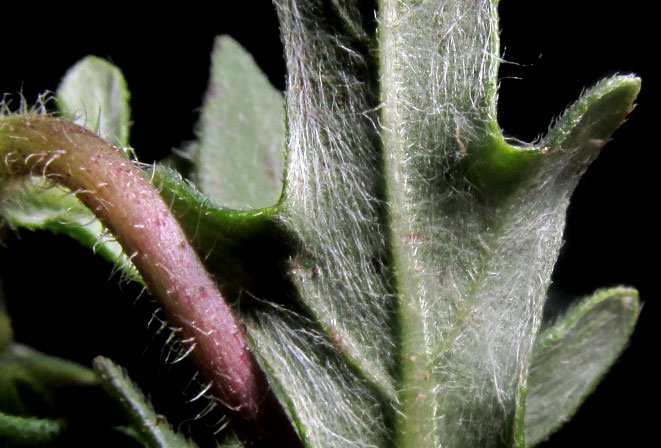Excerpts from Jim Conrad's
Naturalist Newsletter
entry dated Setember 23, 2022, issued from near Tequisquiapan, elevation about 1,900m (6200 ft), N20.565°, W99.890°, Querétaro state, MÉXICO
ROUGH BLACKFOOT

On a grossly overgrazed, scrubby slope much hacked over by firewood gatherers, in very thin, eroded dirt amid outcrops of stone-like, compacted sediment from surrounding volcanic hills, I stooped down to look closer at a certain plant. That plant turned out to be nothing special, but below it, another smaller plant bore the truly strange flowering head, or capitulum, shown above.
Five green somethings surrounded what seemed to be disc florets of the kind produced by species in the vast Composite or Aster Family. The dark cylinder around the vertical yellow pillar in the floret in the very center looked like five anthers joined by their edges around the style, exactly as expected in a disc floret. But, the green, cuplike things with crooked rims and a minuscule yellow, scoop-shaped item on the rim's lower, inner side... remarkable.

Above, from the side, the arrangement still was mystifying. The disc florets' fuzzy style arms and five corolla lobes were "normal," but the five green things, which logically must have been the ray florets, were something new for me. It was all very small and that day by chance I carried a ruler marked in millimeters. Here you can see the scale of things:

In the above picture, other than the smallness, it's notable that the capitulum at the left displays the green, scoop-shaped things, while the capitulum on the right, growing beside it on the same plant, doesn't. Rather, the capitulum on the right displays five very short but otherwise normal ray-floret rays. Here's what the whole diminutive plant looked like:

Most of the plant's leaves lacked teeth or lobes, but the largest leaf was lobed toward the base, and some of the smaller ones hinted of lobes. Also, the white-silky hairiness found on leaf undersurfaces was worthy of a closer look:

Where in the enormous Aster Family with its more than 1620 genera and 23,600 species does this plant fit? I drew a blank until I remembered, back in the Yucatan, the little Butter Daisy, Melampodium divaricatum. It didn't much look like our present plant, but its cypsela-type fruits were weird looking, and rays on its ray florets arose from the back, or inside, of the cypsela, exactly where our current cypselae produced their very tiny yellow items.
Fortunately, Tod F. Stuessy's 1972 "Revision of the Genus Melampodium (Compositae: Heliantheae)" was freely available online, and this wonderful publication included drawings of representative fruit types found in the genus Melampodium. His drawing of a cypsela with a "hood" and a dark, grainy, attenuated base matched our capitula's five green mystery items.
Using Stuessy's identification key, our plant revealed itself as MELAMPODIUM SERICEUM, sometimes known as Rough Blackfoot Daisy. The blackfoot part of the name is of uncertain origin. Some say that the genus name Melampodium may be derived from the Greek melas, meaning black, and podion meaning foot, but others insist that it comes from the name of Melampus, a famous soothsayer in Greek mythology. Whatever the case, our plants have no black feet, and that's just the way common names go.
Our plant turned out not to be very mysterious after all. Stuessy describes the ray, or ligule, length in this species as 0.8-2.2mm long (1/32-3/32 inch), and our picture with the ruler is agreeable with that. Probably our picture of one capitulum with very tiny rays and another with more developed ones simply shows two capitula at different stages of development. Our plant being a young one probably also explains why its capitula appear to have no or very short peduncles, instead of the longer ones seen in images of the species. Instead of mystery, I'm left astonished that the genus Melampodium is capable of such diverse appearances, and flexibility within its species.
Rough Blackfoot Daisy occurs from northwestern Mexico south in uplands to El Salvador, mainly at elevations of 1100-2590m (3500-8500), in oak and pine forests, as well as in disturbed areas from cornfields and roadsides to abandoned lots in towns.
Our plant must be too small to be thought of as "useful" to people, other than livestock eating them. However, Jamie McCann and others, for their 2018 publication "Origin and Genomic Evolution of Polyploid Complexes in the Melampodium (Asteraceae)," developed some interesting facts about the species. They found that Melampodium sericeum is an "allohexaploid derivative" of the allotetraploid species Melampodium strigosum, which it looks very much like. Moreover, our species' genes indicate that it arose during the Pleistocene Epoch, or "Ice age," some 1.4 million years ago, which is fairly recent in terms of evolution and geological time.
Being an "allohexaploid derivative of an allotetraploid" means that our species spontaneously and instantly came into being, possessing six times the normal number of two sets of chromosomes. The mother species, Melampodium strigosum, herself already possessed four times the normal number. Especially among mammals and birds, such error-based multiplication of chromosomes, this "polyploidy," normally is fatal, though over time it's become common among plant species surviving today. Moreover, sometimes newly appeared polyploid species do very well, and even may eventually produce their own polyploid offspring species with even more chromosomes, as in the case of our blackfoot daisy.
In fact, polyploidy probably is responsible for why Melampodium sericeum is so commonly found in very disturbed habitats in which most plants can't survive: Our plant has such genetic diversity within its six complete sets of chromosomes that when it's challenged, there's more likelihood of some of its genes offering a workaround for the problem, than if it were a normal species with only two sets of chromosomes.
What a remarkable creation our quirky-looking little weed turned out to be.